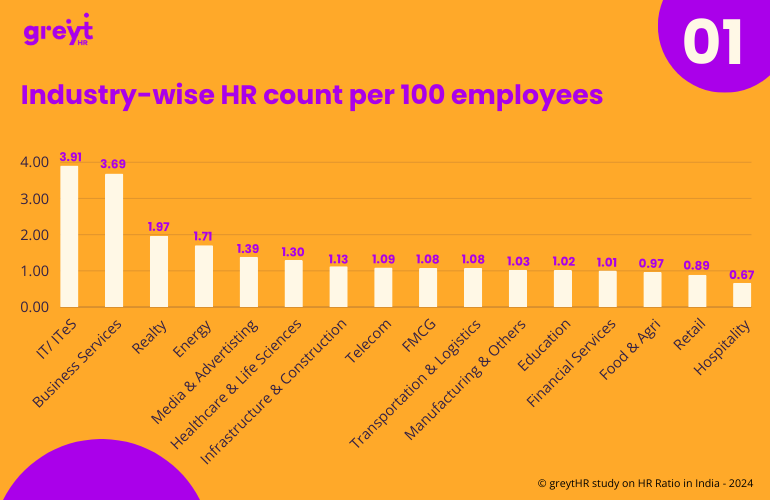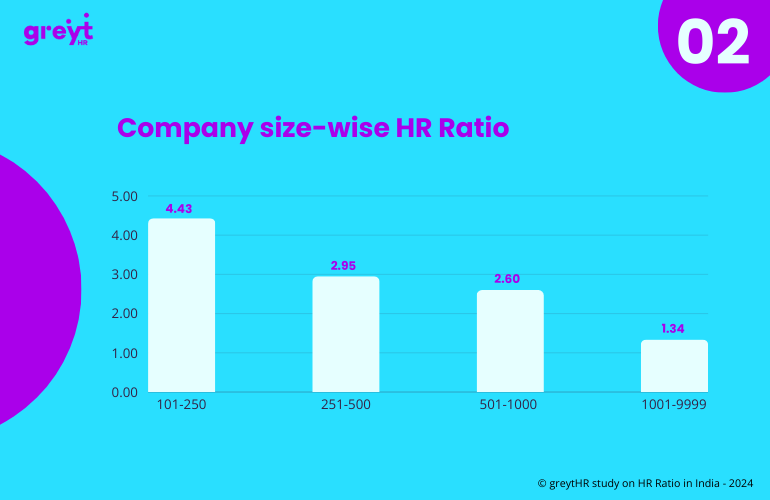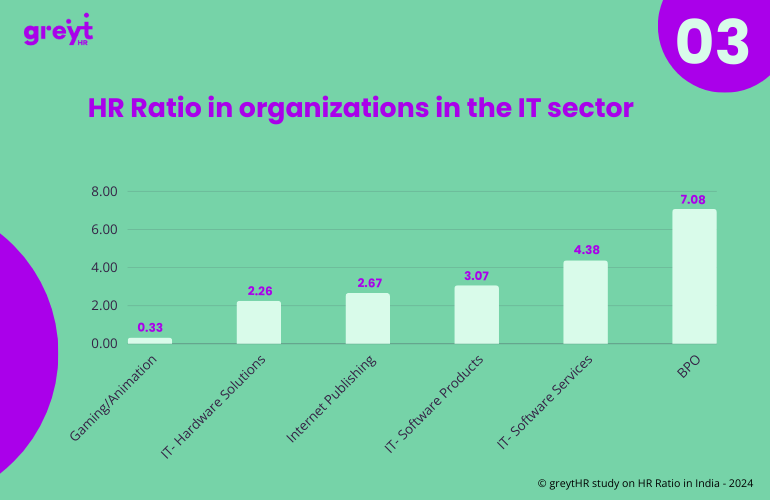Human Resource professionals are not just the architects of workplace culture; they are the unsung heroes who empower and uplift every facet of organizational life. In celebration of International Human Resource Day, we are proud to release "2024 HR Ratio in India: A greytHR Report," which explores how over 10,000 businesses employ and manage their human resources, impacting more than 1.8 million individuals.
This analysis provides a detailed examination of HR ratios across various industries and company sizes, highlighting their influence on operational effectiveness and organizational cultural dynamics. Join us in understanding the significance of HR ratios and what they could mean for your industry or organization.
Table of Contents
- 1. Getting Started: What is Human Resource Ratio and How It Matters
- 2. Methodology of Analysis
- 3. Analysis & Findings
- 4. Summary
- 5. Concluding Remarks: Is Your HR Department Meeting Today's Challenges?
Getting Started: What is Human Resource Ratio and How It Matters
What Is the Human Resource Ratio?
Human Resource Ratio (HR to Employee Ratio x 100): This metric, calculated as (Number of HR employees / Total number of employees) x 100, serves as an essential tool in workforce planning.
This ratio gives insight into the number of human resources professionals in the company for every 100 employees. It helps assess an organization's capacity for effective HR management and strategic planning. It can also influence key business areas such as cost management, resource allocation, and scalability.
Calculating the Human Resource Ratio
To determine this ratio:
- Count the HR professionals employed by the organization.
- Divide this by the total number of employees.
- Multiply the result by 100 to find the percentage.
For example, if there are 20 HR professionals in a company with 1,000 total employees, the HR to Employee ratio would be 2%, indicating two HR professionals per 100 employees. This streamlined metric serves as a foundation for a deeper analysis of HR efficiency and organizational impact.
Methodology of Analysis
We analyzed the human resource ratios of over 10,000 Indian companies, collectively employing more than 1.8 million individuals, segmented by industry and size, to identify patterns in HR staffing trends. Our study utilized anonymized and aggregated data to ensure that no personal information was accessed. Covering organizations with employee counts ranging from 101 to 10,000, our analysis highlights how HR ratios vary and their impacts on operational effectiveness and organizational culture.
Analysis & Findings
Industry-Specific Trends

Higher HR Ratios in Knowledge-Intensive and Innovation-Driven Industries
In sectors like IT and Business Services, which thrive on knowledge and continuous innovation, HR ratios are notably higher. This underscores HR's crucial investments in recruiting top talent and facilitating ongoing professional development. More than just supporting operations, HR plays a pivotal role in managing a dynamic workforce that constantly adapts and grows, ensuring that the organization remains at the forefront of innovation.
Lower HR Ratios in Routine and Operational Industries
In contrast, sectors such as Retail and Hospitality, which often involve more standardized job roles and require less specialized skills, maintain lower HR ratios. This suggests that the operational demands in these industries require less HR intervention for employee management, focusing more on efficiency and routine tasks rather than strategic HR initiatives.
Company Size Dynamics
Leaner with Scale: HR Efficiency Gains as Companies Grow

- Smaller Companies (Fewer than 250 employees): These organizations typically exhibit higher HR ratios, suggesting that HR plays a crucial role in establishing strong foundational practices. For these firms, HR is not just about managing talent but is deeply involved in shaping organizational culture, compliance, and internal growth strategies.
- Scaling with Size (1,000 to 9,999 employees): As companies grow, there's a visible trend of decreasing HR ratios. This shift is partly due to the implementation of automated systems and HR technologies that allow for the management of a larger number of employees without a proportional increase in HR staff. The trend suggests that larger companies might achieve efficiency through technology, reducing the need for a high HR-to-employee ratio.
- Strategic Implication ‒ Balance is the key: Very low HR ratios can lead to increased employee turnover, while very high HR ratios may lead to inefficiencies. Optimal HR staffing levels are crucial for maintaining employee satisfaction, operational costs, and organizational stability.
Our findings are consistent with recent studies, including SHRM’s 2022 Human Capital Benchmark Report, which indicates an average HR staff-to-employee ratio of 1.7 per 100. Other studies have noted similar trends, further reinforcing our observations.
The Evolving Role of HR in the Age of Technology: Exploring the IT Sector Further

While our report focuses on the current state of HR ratios, the influence of emerging technologies, such as AI and automation, in shaping future HR practices is undeniable. Recent shifts in the industry, marked by layoffs due to technological integration, highlight a significant and ongoing transformation in the HR landscape.
Imagine HR departments in top tech firms using AI to predict staffing needs and automate tasks with incredible accuracy. As generative AI reshapes the HR landscape, it not only simplifies operations but also demands a new type of HR professional: a strategist skilled in using AI to enhance employee engagement and provide strategic foresight.
However, a striking contrast emerges when comparing sectors like high-tech software development to Business Process Outsourcing (BPO). While tech firms increasingly lean on automation, the BPO sector, with its HR ratio peaking at 7.08 as shown in our chart, suggests a persistent reliance on intensive human-centered HR management. This is likely due to the high employee interaction required in BPO settings, requiring continual soft skills and customer service training.
This disparity provokes a question: How will generative AI impact these divergent HR strategies?
The role of HR is rapidly evolving. Our study reveals significant disparities in HR strategies across sectors, underscoring the need for a tailored approach to HR management, attuned to organizations' unique operational and human capital needs. This customization not only helps HR departments manage change effectively but also ensures they excel, aligning employee satisfaction with broader organizational goals.
Summary
As we conclude our analysis of HR ratios across 10,000+ Indian companies, several key themes have emerged:
- Strategic Investment: High HR ratios in sectors like IT and Business Services emphasize the need for strategic HR to drive innovation and handle complex workforce requirements
- Operational Efficiency: Conversely, sectors like Retail and Hospitality, with lower HR ratios, emphasize the importance of efficiency over strategic HR involvement.
- Scalability and Automation: The trend of decreasing HR ratios with company growth illustrates the impact of automation and technology, suggesting that larger organizations can achieve greater efficiency through these means.
- Technological Transformation: AI and automation are increasingly streamlining HR operations and shifting HR’s role towards strategic engagement and foresight.
Concluding Remarks: Is Your HR Department Meeting Today's Challenges?
Our “2024 HR Ratio in India: A greytHR Report" is released on International Human Resource Day as a tool for reflection and planning. It invites HR professionals and business leaders to delve into the findings and consider the implications for their strategies as they integrate emerging technologies.
We encourage you to engage with our findings and consider how your organization can adapt to these insights. As you consider the insights from this comprehensive study, here are essential questions to guide your strategic evaluation and planning:
- Does your current HR ratio align with industry norms and the size of your company?
- How can your organization effectively use HR data analytics to enhance strategic decision-making and operational efficiency?
- What strategies are in place to transition from traditional HR functions to more strategic, technology-driven roles?
- How will you implement HR tech and AI to boost efficiency and drive innovation faster?
As technology has begun reshaping traditional roles, the ability of your HR department to adapt and innovate becomes increasingly crucial. It is essential to assess, plan, and act now to ensure that your HR capabilities are robust, forward-thinking, and equipped to handle today's challenges.
Let this report catalyze your strategic planning, helping your organization to not just adapt, but thrive in the rapidly evolving corporate landscape.
About greytHR
greytHR is a full-suite HRMS, with the most advanced Payroll and Workforce Management in India and the Middle East region.
greytHR simplifies, expedites, and even automates complex, recurring, and yet critical functions of HR and Payroll, in a compliant and secure way. greytHR offers productivity tools for better people management, simpler HR processes, and professional delivery of HR and Payroll services.
With a broad range of HR products, greytHR is particularly strong in Administrative HR, Payroll, Workforce Management, and Employee Engagement. The platform also offers an app marketplace (to enable affinity use cases), mobile ESS, and lossless implementation. While other HR products barely scratch the surface, greytHR has productized deep and complex HR tasks.
Currently, greytHR is trusted by over 23,000 organizations and 2.3 million users across more than 25 countries, including the UAE, Saudi Arabia, Qatar, Oman, Kuwait, and Bahrain, highlighting its global reliability and effectiveness.
Disclaimer
The findings presented in this data story are based on a specific and limited data set. While the insights provided offer valuable perspectives, it is important to exercise discretion when applying these findings to other sectors or business contexts. We encourage readers to interpret and apply the data thoughtfully, considering their organizational context and consulting additional resources or experts as needed.
